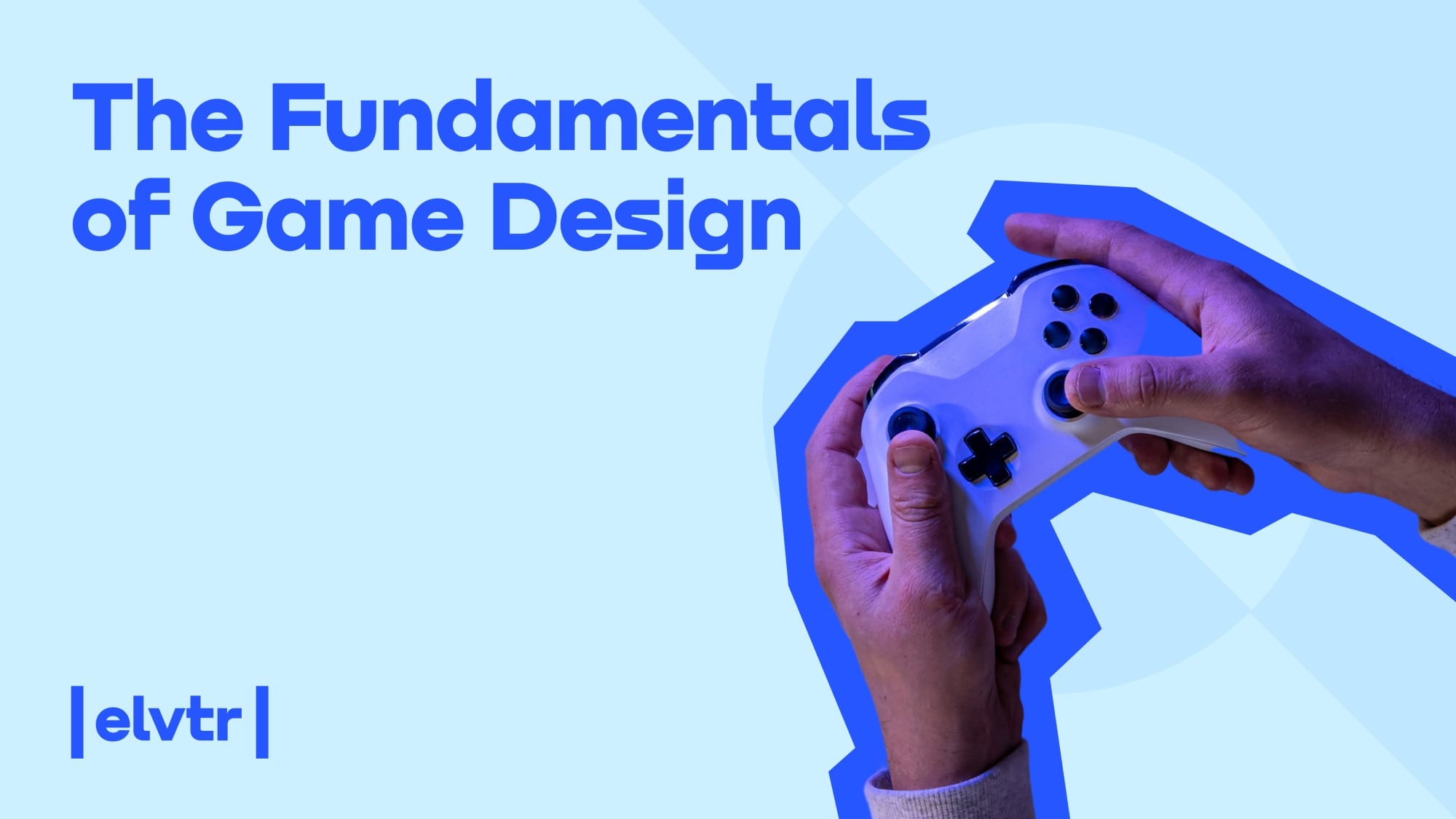- MAIN PAGE
- – elvtr magazine – THE FUNDAMENTALS OF GAME DESIGN
THE FUNDAMENTALS OF GAME DESIGN

Games have the incredible ability to transport us to fantastical worlds and boost our imagination. Have you ever wondered what it takes to create these captivating worlds? If you're a dreamer, an innovator, and a lover of games, then the art of game design probably beckons you.
The game development process itself is a journey filled with creativity and problem-solving. From brainstorming ideas to prototyping concepts and refining gameplay elements, each step contributes to shaping a unique gaming experience.
So whether you're an aspiring game designer or simply curious about what goes on behind the scenes of your favorite games, this article will provide you with knowledge about the fundamentals of game design.
Are you ready to dive into the exciting world of game design? Let's explore the fundamentals that lay the foundation for creating captivating and immersive gaming experiences.
Game Design and Its Main Components
At its core, game design is the art of crafting experiences that engage and entertain players.
Game design is the process of creating and designing a game's rules, mechanics, goals, and overall experience. It involves making decisions about how the game should be played, what challenges and obstacles players will face, and how they will interact with the game world.
Game design is a blueprint for a game, where you decide what elements should be included and how they fit together. It's all about using creativity and strategy to shape how people have fun and experience a game.
Here are the main components of a game each game designer needs to consider:
- Game mechanics. These are the rules and systems that make a game work. They determine what players can do, their challenges, and their actions' outcomes.
- Objectives and goals. Games need clear objectives and goals to give players a sense of purpose and direction. It's like a mission or target to achieve while playing.
- Player agency. It’s players’ ability to make choices and impact the game. Having the power to decide what happens next and feeling in control of actions makes players more engaged.
- Progression and rewards. Games often have systems that allow players to progress and earn rewards as they play. They include unlocking new levels, getting stronger, or receiving special items for completing tasks.
- Balance and difficulty. Games should be challenging but not too hard or too easy. The goal is to find the right balance, so players stay motivated.
- Feedback. Games provide feedback to players through visuals, sounds, and controls. Designers also listen to feedback from players and make improvements to the game based on their suggestions.
- Immersion and narrative. Games create immersive experiences by telling stories, creating interesting characters, and designing captivating environments. It’s the feeling of being connected to the game's universe.
Recommended courses
What Are the Main Stages of Game Design?
Everything starts with an idea or a concept. It might be a cool character, a story, or your vision of a game world. While game design might sound like something on the creative side, you also need to have some technical knowledge and background to communicate with your team effectively. Things get more technical during the following stages, which we will discuss below.
Let's dive into each step of game design in more detail:
- Concept. The concept stage is where the initial idea for the game is formed. It could be inspired by a story, a unique gameplay mechanic, or a combination of both. A designer brainstorms ideas and considers the target audience, market trends, and the overall vision for the game.
- Planning. During the planning stage, a game designer creates a detailed plan for the game. They define the goals and objectives, determine the target audience, and outline the core gameplay mechanics. They also consider the game's structure, such as levels or chapters, and the difficulty progression. Additionally, the designer may create concept art or write a game design document to communicate their vision to the development team.
- Prototyping. In the prototyping stage, a basic game version is created to test its core mechanics and concepts. This prototype can be a simple version of the game using placeholders for artwork and sound. It allows a designer to experiment, gather feedback, and adjust the gameplay.
- Iteration. Iteration involves refining and improving the game based on feedback received during prototyping. A designer analyzes the gameplay experience, addresses any issues or concerns, and makes adjustments to enhance the game's quality. It can involve multiple cycles of testing, gathering feedback, and implementing changes until the game is polished.
- Art and sound design. The art and sound design stage focuses on creating the visual and auditory elements of the game. Artists work on character designs, environment art, and visual effects, while sound designers craft music, sound effects, and dialogue. These elements complement the gameplay, evoke emotions, and create an immersive player experience.
- Development. During the development stage, the actual coding and programming of the game take place. A designer works with programmers and developers to bring the game to life. Together, they implement the planned gameplay mechanics, integrate artwork and sound, and ensure the game runs smoothly on various platforms or devices.
- Testing and balancing. Testing and balancing are essential to ensure the game is enjoyable, fair, and free of bugs. Testers play the game, searching for issues, glitches, or imbalances. A designer collects feedback, identifies problems, and works with the development team to fix them. Balancing involves adjusting the difficulty, pacing, and mechanics to provide an optimal player experience.
- Release. Once the game is considered ready, it is released to the public. This stage involves marketing efforts to build awareness and generate excitement around the game. Marketers choose distribution channels, which can include online platforms, app stores, or physical copies. Then a game is available to players, who can purchase, download, or access it.
- Post-release support. After a game is released, a designer continues supporting it by listening to player feedback, addressing any issues, and providing updates to improve it. They may also engage with the game's community, interacting with players, organizing events, and fostering a positive environment.
How to Become a Game Designer?
While there isn't a fixed blueprint, here's some guidance on the educational background and steps you can consider:
- Education. A degree in game design, computer science, interactive media, or a related field is the most obvious path that should give you a good foundation. However, formal education is not the only path: Many successful game designers have learned through self-study and practice.
- Develop skills. Focus on developing various skills essential to game design. These include:
- Game design principles. Study the fundamentals of game design, game mechanics, player motivation, level design, and user experience (UX) design.
- Programming and scripting. Learn the basics of programming languages commonly used in game development (C++, C#, or Python). Knowledge of scripting languages like Lua or JavaScript can also be valuable.
- Art and design. Gain knowledge in 2D and 3D art, animation, graphic design, and visual storytelling. You can also benefit from knowing design software such as Photoshop or Maya.
- Communication and collaboration. Game design often involves working in teams. Strengthen your communication, teamwork, and collaboration skills.
- Build a portfolio. Include examples of game prototypes, level designs, documentation, or other relevant work.
- Gain experience. This can involve working on personal projects, participating in game jams, contributing to open-source projects, or interning at game studios. Building a network within the gaming industry can also provide you with connections and opportunities.
- Stay updated. Research new game releases, attend conferences or events, join online communities, and follow game design blogs and podcasts.
- Specialize. As you gain experience, consider specializing in a specific area of game design that aligns with your interests and strengths. This could be character design, narrative design, level design, game mechanics, or user experience (UX) design.
Ready to unleash your creativity and bring your game ideas to life? Take a look at our Game Design course and discover the secrets behind captivating game experiences. From designing thrilling gameplay mechanics to crafting immersive narratives, this course covers it all!
Immerse yourself in hands-on projects, where you'll bring your game ideas to life from concept to completion. Learn from experts who will share their experiences and fuel your passion for the craft. Get career advice and learn how to monetize your passion for gaming.
So, dare to dream big, dare to think differently, and dare to leave your mark on the gaming landscape. The world is waiting for your unique vision. Happy designing!
*ELVTR is disrupting education by putting proven industry leaders in a virtual classroom with eager rising stars. ELVTR courses offer 100% instructor driven content designed to give you practical knowledge within a convenient time frame. Choose the right course for you!
